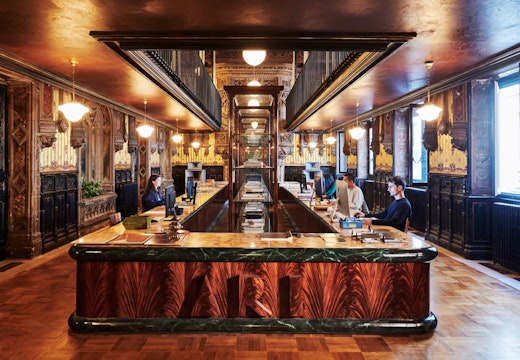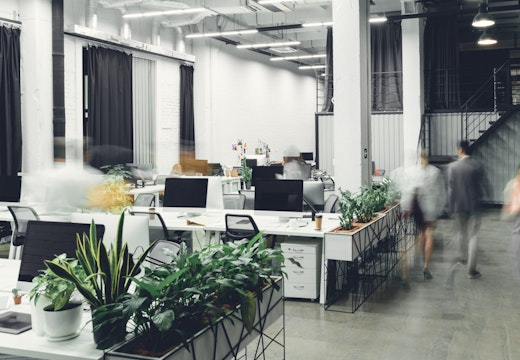Question of focus: how can office design address new priorities?
What’s holding people back from returning to the office? New U.S data tracked by global design firm Gensler explores how employee priorities are changing in favour of supporting individual work
The post-pandemic office has been championed as a space to reconnect with colleagues, engage in social activities and reignite interpersonal interactions we had lost from spending a significant amount of time apart. But new research suggests that priorities are changing for office workers on what they want from their workspaces.
The latest data from Gensler’s U.S. workplace survey reveals new intelligence on the role the office plays in a new ecosystem for work. The survey, based on more than 2,000 U.S. office workers across 10 industries, found that the most important reason employees want to return to the office is simply to get their work done.
Throughout the pandemic, Gensler conducted six workplace research surveys in the U.S. Each time the top-ranked reason to come into the office was to ‘work with colleagues.’ Now, for the first time, employees have cited ‘to focus on my work’ as their top priority for coming into the office. This finding indicates a departure from the post Covid-19 narrative that the office is a vehicle exclusively for connection and collaboration. As organisations continue to recalibrate the office to fit into a new context of work, this data reveals new insights into what the post-pandemic office might look like.
Space to be productive
While hybrid may be the buzzword of the pandemic, it is not a new concept. Office workers have always been mobile – working both in and out of the office. The average percentage of time in the office has hovered around 80 per cent of a typical work week since 2016. However, the Gensler data shows that workers at the most innovative companies spent less time in the office, decreasing to 67 per cent of the work week right before the pandemic hit.
The research investigated how much time employees perceive that they ‘need’ to spend in the office to maximise their individual and team productivity. On average, employees working in the most innovative companies are currently working in the office around 50 per cent of a typical work week but they say they needed to spend closer to 70 per cent of their time in a typical work week in the office to maximise their productivity.
This begs the question: why aren’t workers coming into the office more frequently if they believe it benefits their productivity levels? The answer might lie in how the office is currently designed.
Multi-modal workplace
In placing exaggerated importance on the role of collaboration in the office during the pandemic, many organisations redesigned their workspaces to focus on in-person social and collaborative interactions. In doing so, many neglected to acknowledge the critical role the office continues to play in supporting individual work and virtual collaboration with others.
‘Workspace effectiveness for individual work is at its lowest level in 15 years…’
Gensler’s data reveals that office workers in the U.S. spend more than a third of their time (34 per cent) working alone and 15 per cent of their time working with others virtually. Workers say that 69 per cent of working alone requires a high level of concentration. Yet, the data indicates that the effectiveness of the workplace for supporting individual work and virtual collaborative work is continuing to decline – and they are currently at the lowest levels they have been since Gensler started measuring workspace effectiveness in 2008.
On the other hand, the effectiveness of social, learning and in-person collaborative spaces are on the rise. As the dust continues to settle on the impact of hybrid working, employees’ priorities for the office will continue to shift and workplaces need to be resilient and flexible to accommodate for this volatility. Providing the right physical work environment, which minimises noise, distractions and interruptions, is important to keep people focused on their work and performing at their best.
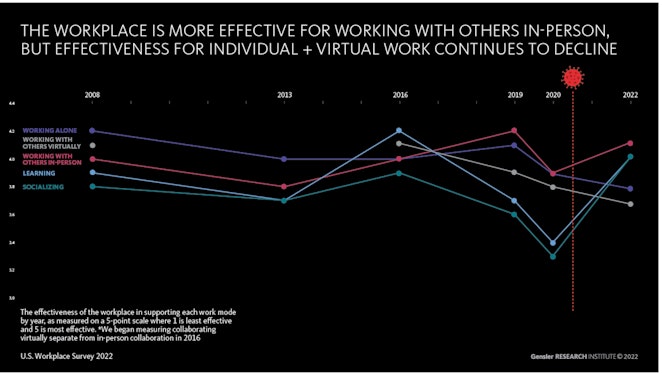
Image: Courtesy of Gensler
Recalibrating office experience
Before the Covid-19 pandemic, the workplace was on a trajectory toward diversifying experience to match the dynamic nature of work. Now, these expectations have been amplified and office workers want a more diverse mix of experiences – so much so that a large majority of hybrid workers (83 per cent) report that they would be more willing to return to the office more regularly if their ideal experiences were met.
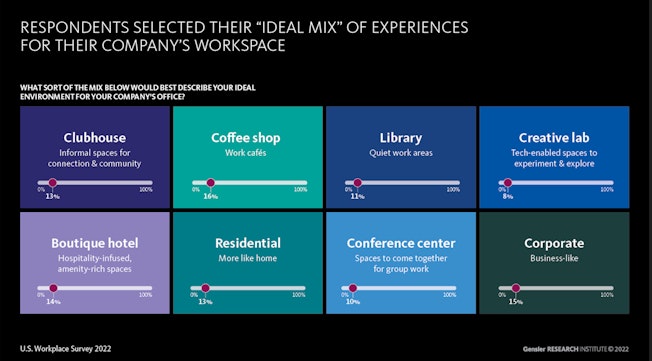
Image: Courtesy of Gensler
Gensler asked U.S. office workers to map their ideal workplace experiences based on eight different environments. The results indicate that younger generations have a clear preference for hospitality-infused experiences such as coffee shops and boutique hotels, while older workers prefer a blend of business-like and hospitality-focused work experiences. This signals a shift away from mundane office designs which prioritise corporate function, towards more casual work settings.
Spaces with greatest impact
The research highlights key amenities and workspaces which have the greatest impact on workspace effectiveness and experience. Spaces that facilitate individual quiet work such as tech-free zones, focus rooms and rest spaces, and space for creative group work such as innovation hubs and maker spaces, have the most significant impact on workspace effectiveness and experience. These types of workspaces differentiated the ‘highest performing workplaces’ from the lowest performing ones.
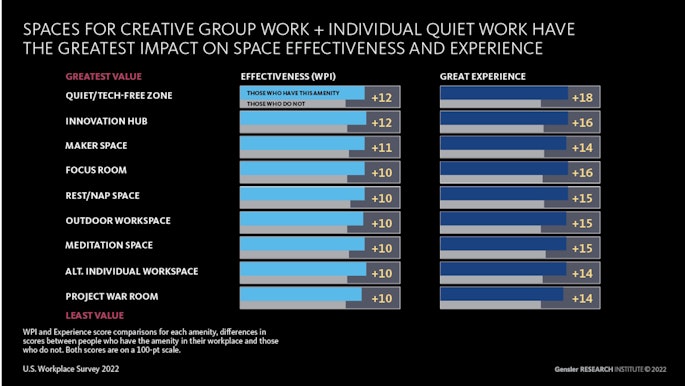
Image: Courtesy of Gensler
Companies that provide both effective spaces and great work experiences are more likely to be found in amenity-rich neighbourhoods. Their workers have access to a wider diversity of amenities ranging from coffee shops and outdoor spaces to eateries and grocery stores, either on-site or near the office.
As organisations continue to navigate the turbulent impacts of hybrid working, Gensler’s latest research into the U.S. workplace highlights that the office still has an important role to play in the future of work, but how we curate experiences and facilitate spaces to get work done effectively needs a critical re-evaluation. Read more on the U.S. study here.


